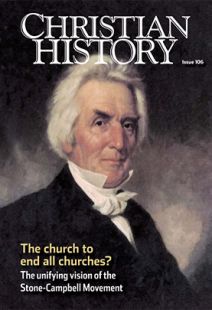How to speak Stone-Campbell
The Stone-Campbell movement today comprises three distinct bodies: Christian Church (Disciples of Christ), Churches of Christ, and Christian Churches/Churches of Christ. Congregations of the movement in the nineteenth century were known by several versions of these names. But division became a settled reality in the twentieth century.
Congregations who did not worship with instrumental music or conduct missionary work through organized societies were known by the early 1900s as Churches of Christ. Congregations using instruments and cooperating with missionary societies were called Christian Churches or Disciples of Christ.
In 1968 the more progressive wing of the Christian Churches, through a process called Restructure, formed a mainline Protestant denomination: The Christian Church (Disciples of Christ). Those not wishing to be identified with that denomination are often called Independents and usually refer to themselves as Christian Churches/Churches of Christ.
A Cappella Churches of Christ:Or “Churches of Christ.” This stream of the Stone-Campbell Movement rejects instrumental music in worship, arguing that Scripture does not authorize it.
“Antis:” This common term is used (1) by members of Disciples and Christian Churches to describe Churches of Christ who oppose missionary societies and instrumental music in worship; (2) within Churches of Christ for a number of twentieth-century groups who “stand out” by opposing parachurch organizations, Sunday schools, ministers drawing salaries and settled in one congregation, and multiple cups in the Lord’s Supper; and (3) by Disciplesfor those who opposed the Restructure in 1968 that made Disciples into a mainstream denomination.
The Brotherhood: Designation for a speaker’s group of churches, much like “the Church.” For example, “I read three brotherhood papers every month.”
Campbellite:Pejorative label applied by opponents to members and churches of the movement accusing them of being followers of Alexander Campbell; almost always rejected by insiders.
Christian Church (Disciples of Christ):Name adopted in 1968 during the “Restructure” of the Disciples. The shift from plural “Christian Churches” to singular “Christian Church” reflected this stream’s embrace of a corporate, denominational identity.
Christian Churches/Churches of Christ: Congregations that chose not to continue affiliation with Disciples of Christafter the 1968 Restructure. These were generally more theologically conservative congregations reflecting evangelical values.
Christian Movement, Christian Church: Many movements in early America that sought to recover the simplicity of the early church used the generic name “Christian” instead of denominational names they believed to be unscriptural and divisive.
“The Church:” Used by insiders before the various divisions to refer to all the churches of the Stone-Campbell Movement. After the divisions, used to designate the specific stream of the speaker.
church(es) of Christ: A little “c” is used by some congregations to indicate that they do not see themselves as part of a denomination or historical tradition, but simply as a church that belongs to Christ.
Disciples of Christ, disciples Movement: Widely used designation for the whole movement in the early twentieth century.
Independent Christian Churches:Same as Christian Churches/Churches of Christ. The name reflects that these congregations undertake independent mission efforts because they object to the practice of open membership and to perceived liberal theology among Disciplesleaders.
Lectureships/CONventions: Annual gatheringsoften sponsored by educational institutions. They provide worship, fellowship, classes, and workshops but have no legislative function or authority.
NACC: North American Christian Convention, the largest annual gathering of members of Christian Churches/Churches of Christ. It began in 1927 as a fellowship meeting for those who had reservations about the leadership of the Disciples.
Open Membership: Practice of allowing nonimmersed persons—usually those baptized as infants in another Christian body—to become members of a Stone-Campbell congregation. Stone’s movement generally practiced open membership; Campbell’s did not. This became a heated issue amongDisciples in the twentieth century, contributing to division.
Plan of Salvation: The five steps needed to receive God’s redemption: hear the gospel, believe in Christ, repent of one’s sins, confess one’s faith in Christ, be baptized by immersion.
The Reformation of the Nineteenth Century: Most common designation for the movement at its beginning, along with “the current reformation.”
Restoration Movement: Common designation for the movement, reflecting the ideal of restoring beliefs and practices of the New Testament church perceived to have been lost, neglected, or corrupted. This idea was also often used by Latter Day Saints traditions.
Stone-Campbell Movement: New name proposed by historian Leroy Garrett in The Stone-Campbell Movement: An Anecdotal History of Three Churches (1981). Some resisted the name because they felt Campbell should be listed first; others thought it abandoned the “Restoration Ideal.” Still, it is currently the most widely used designation for a movement that embraces three distinct churches. CH
By Douglas A. Foster and McGarvey Ice
[Christian History originally published this article in Christian History Issue #106 in 2013]
Next articles
Reading the Bible to enjoy the God of the Bible
Connecting the life of the mind to the world of revivalism
Richard HughesNorth and South
Was the division in the “unity movement” as much about geography as theology?
Richard HughesClimbing into the mainline boat
Early Disciples of Christ resisted all “man-made” denominations; so how did some of them become one?
Mark G. ToulouseChristian History Timeline: From Stone and Campbell to the Great Communion
The unity movement begun by Stone and the Campbells soon encountered division
Compiled by McGarvey Ice and the editorsSupport us
Christian History Institute (CHI) is a non-profit Pennsylvania corporation founded in 1982. Your donations support the continuation of this ministry
Donate



